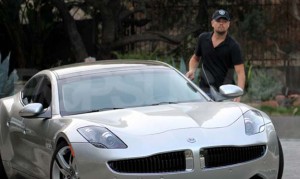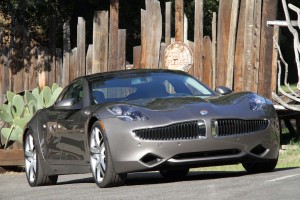Will the reborn Fisker Automotive find good Karma or bad juju with a new name?
The now Chinese-owned carmaker has been struggling to emerge from its 2013 bankruptcy and resume production of the sleek plug-in Karma hybrid that once carried a price tag of just over $100,000. But fearing that the Fisker name would bring to the public’s mind the company’s well-publicized problems, it has decided to rechristen itself Karma Automotive.
The question is whether the carmaker’s only product will now be known as the Karma Karma – and whether that will translate into better luck after Fisker Automotive’s decidedly poor, initial karmic experience.
“Karma was chosen because its relevant to both the old and new brands, and also because it says something important about the new company,” explained a terse statement. “The understanding of the principle of cause and effect, where your actions create your future. Acting with intention is what the new Karma represents.”
The release also emphasized the company’s “NEW” ownership and management.
(Click Here to check out the new Tesla Model X battery-SUV.)
In its original form, Fisker Automotive was founded by Henrik Fisker, a Danish designer best known for his work on exotic imports like the Aston Martin DB9. He was determined to show that battery-based vehicles didn’t have to be slow and stodgy. Repeatedly delayed, it finally went on sale in 2012, with a number of high-profile celebrities, such as Leonardo di Caprio both investing in the company and signing up for some of the first cars.

Fisker initially attracted the attention of a number of high-profile buyers, including actor Leonardo DiCaprio.
But the Karma received a mixed reception from the media and ran into a series of problems, including several that required recalls.
The company itself raised over $1 billion from investors but was quickly knee-deep in financial problems that were worsened when the federal government decided to halt paying out from a government fund intended to support the development of clean, high-mileage battery vehicles. Development on a second, more mainstream model was delayed and production of the Karma was halted at the plant Fisker was using in Finland.
On November 22, 2013, Fisker Automotive filed for bankruptcy. Unable to come up with a turnaround plan it was soon liquidated, key assets sold to China’s Wanxiang Group.
Hiring a handful of veteran automotive executives, including former Cadillac brand boss Jim Taylor, Wanxiang began to pull together a plan to relaunch Fisker. It plans to start with an only slightly updated version of the Karma sports sedan that Fisker Automotive was producing when it went broke. But the goal is to quickly address key concerns, among other things finding a more advanced “range-extender” gasoline engine. The first-gen Karma used a four-cylinder package provided by General Motors.
Insiders have told TheDetroitBureau.com they hope to nonetheless address about 250 significant problems left unresolved by the original development team that led to reports by consumers of fire problems and software failures.
(Honda plans to reveal all-new hydrogen car at Tokyo Motor Show. Click Here for more.)
The decision to first start out by changing the company’s name is no surprise. Many analysts have suggested the Fisker badge was simply too tarnished to be reused. But the Chinese, it turns out, only had a short-term license for the Fisker name, anyway, according to several sources close to the company.
Originally, Wanxiang had considered rechristening the brand Elux, a name that appears to have generated little enthusiasm from potential buyers. But whether Karma will develop better karma remains to be seen.
Another key question is how Karma, the car, will be marketed – and where. Early on, some reports suggested it would be targeted at China, where government overseers have been pressing the auto industry to switch to battery power to address endemic smog problems. But insiders say they’ll also be targeting the U.S. market and, as they had planned originally, the goal is to win over some of the same buyers now opting for the Tesla Model S.
Karma Automotive is also expected to resume development of the more mainstream Atlantic model that was put on hold nearly three years ago.
(Mercedes takes aim at Tesla with 311-mile battery SUV. Click Here for the story.)


More than likely the karma this time is going to be like the karma last time, riddled in financial losses.
I’d want the Karma Karma with the Chameleon trim.